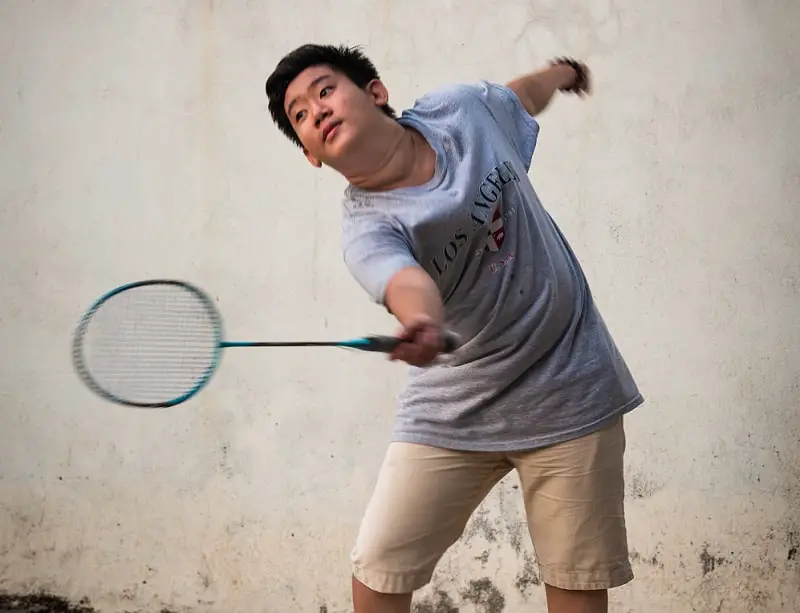The method of using your equipment can be the difference between winning and losing a sports match. When a person starts playing a sport, the first thing they are always taught is how to use their equipment correctly. In this article we look to help those beginners who are looking at a guide on how to hold a badminton racket in different correct ways.
What are the Different Types of Badminton Grips? There are different types of grips which can be used while playing badminton, including the handshake grip which is the most basic type and forehand and backhand grip.
These have been explained in the sections below.
Table of Content
Handshake Grip
The basic grip that is used first and foremost for badminton is what is called “The Handshake Grip”. This is called so because the grip seems like you are shaking your hands with someone.
To use this very basic grip, all you have to do is visualize the grip/handle of the racket as another person’s hand coming to shake yours. Grasp the racket handle with your thumb pressing against the flatter side of the grip and the rest of your fingers curling around the grip comfortably.
Also Read:
Remember that the “controlling fingers” for your racket are ONLY the Thumb, Index Finger and Middle Finger. The last two fingers are supposed to grip the handle softly; this is because while playing badminton, you need flexibility in your wrists enough to rotate and flick to make shots at the birdie.
If you were to hold your racket with all five fingers grasping it tightly, you will feel that you lose the flexibility in your wrist than if you had left your ring and pinky finger looser.
You can see the difference for yourself by first making a tight fist and moving around your wrist and then letting the last two fingers loose.
Now that we have the basics out of the way, let us move further to the other types of grasping techniques.
Forehand and Backhand Grips
Beginners often confuse the two grips as they seem identical. Despite looking the same in grasp, the two have widely different uses, and the power to achieve those two different outcomes lies in the finger pressure rather than the grasp itself.
Forehand Grip

This grip is used to make forehand shots, which are shots made with a strike that goes “palm first”; implying the palm of your hand (despite being closed) faces towards the birdie that is in coming.
The forehand grip utilizes the index finger’s power the most. Thus, the grip is the same as the basic Handshake grip, but the index finger is the finger that supplies power to make the shot. Furthermore, keep your thumb lower than your index finger; the thumb should be touching the middle finger during the grip.
Overall, there should be a ‘V’ shape the space between your thumb and index finger makes once you grasp the racket handle properly for a forehand grip.
Pro Tip: You can mark that ‘V’ shape with a marker on the racket for keeping in mind how to place your fingers for the future.
Furthermore, Forehand grips are used when you make shots to the right hand side (assuming your dominant hand is the right hand). You would use forehand grips to make:
- Clear Shots
- Drop Shots
- Smashes
- Drive Shots
- Lift Shots
- Net Shots
- Forehand Low/High Serves
Also Read:
- Everything to Know about Badminton Serve Types
- Badminton Racket Stringing: Tension, Machines & Certification
Backhand Grip

This grip is used to make backhand shots, which are shots made with the back of your hand facing the birdie.
The backhand grip utilizes the power of the thumb to strike the birdie. To make this grip you will hold the racket with your thumb pressing on the flat surface of the grip and the rest of your fingers clasped around the handle normally.
The thumb should be higher than the index finger on the grip, meaning the rest of the fingers are clasped together with the thumb protruding.
Backhand grips are used for shots made on the left side of your body (assuming your dominant hand is the right hand). Furthermore, the Backhand grip is used for:
- Backhand Low Serve
- Backhand Flick Serve
- Backhand Defense
- Backhand Drive
- Backhand Lift
- Backhand Clear
- Backhand Dropshot
- Backhand Net Drop
It is important to note that these both grips are used interchangeably majorly depending on which side of you the opponent attacks at. Hence, it is advised to rest your thumb on the wider surface of the grip comfortably to switch between grips swiftly when needed.
Pro Tip
The simplest way to remember when to keep either grip is to imagine a clock with all 12 hours and you in the centre of it. When the birdie strikes any of the numbers on the clock, it corresponds to using either the forehand or backhand.
Let’s say it hits the 12 o’clock mark, that would mean the birdie is coming towards on top of your head, for which the forehand grip would be best useful.
Similarly, the forehand and backhand grips can be used when your opponent attacks the other areas on the clock based on the table below.
- Forehand Grip: 12 o’clock to 5 o’clock
- Backhand Grip: 6 o’clock to 11 o’clock
To further understand through demonstrations for Forehand and Backhand Grips, watch the YouTube video given:
Wrong Ways to Grip Your Racket
- When your thumb covers any of the other fingers while grasping the racket
- When your index finger is extended completely parallel to the racket’s shaft
- When your thumb is extended completely towards the frame of the racket head


